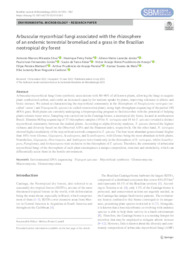Arbuscular mycorrhizal fungi associated with the rhizosphere of an endemic terrestrial bromeliad and a grass in the Brazilian neotropical dry forest.
Arbuscular mycorrhizal fungi associated with the rhizosphere of an endemic terrestrial bromeliad and a grass in the Brazilian neotropical dry forest.
Autoria: SILVA, A. M. M.; FEILER, H. P.; LACERDA-JÚNIOR, G. V.; FERNANDES JUNIOR, P. I.; AIDAR, S. de T.; ARAÚJO, V. A. V. P. de; MATTEOLI, F. P.; PEREIRA, A. P. de A.; MELO, I. S. de; CARDOSO, E. J. B. N.
Resumo: Abstract: Arbuscular mycorrhizal fungi form symbiotic associations with 80?90% of all known plants, allowing the fungi to acquire plant-synthesized carbon, and confer an increased capacity for nutrient uptake by plants, improving tolerance to abiotic and biotic stresses. We aimed at characterizing the mycorrhizal community in the rhizosphere of Neoglaziovia variegata (so-called `caroa`) and Tripogonella spicata (so-called resurrection plant), using high-throughput sequencing of the partial 18S rRNA gene. Both plants are currently undergoing a bioprospecting program to find microbes with the potential of helping plants tolerate water stress. Sampling was carried out in the Caatinga biome, a neotropical dry forest, located in northeastern Brazil. Illumina MiSeq sequencing of 37 rhizosphere samples (19 for N. variegata and 18 for T. spicata) revealed a distinct mycorrhizal community between the studied plants. According to alpha diversity analyses, T. spicata showed the highest richness and diversity based on the Observed ASVs and the Shannon index, respectively. On the other hand, N. variegata showed higher modularity of the mycorrhizal network compared to T. spicata. The four most abundant genera found (higher than 10%) were Glomus, Gigaspora, Acaulospora, and Scutellospora, with Glomus being the most abundant in both plants. Nonetheless, Gigaspora, Diversispora, and Ambispora were found only in the rhizosphere of N. variegata, whilst Scutellospora, Paraglomus, and Archaeospora were exclusive to the rhizosphere of T. spicata. Therefore, the community of arbuscular mycorrhizal fungi of the rhizosphere of each plant encompasses a unique composition, structure and modularity, which can differentially assist them in the hostile environment.
Ano de publicação: 2023
Tipo de publicação: Artigo de periódico
Unidade: Embrapa Semiárido
Observações
1 - Por padrão são exibidas publicações dos últimos 20 anos. Para encontrar publicações mais antigas, configure o filtro ano de publicação, colocando o ano a partir do qual você deseja encontrar publicações. O filtro está na coluna da esquerda na busca acima.
2 - Para ler algumas publicações da Embrapa (apenas as que estão em formato ePub), é necessário ter, no celular ou computador, um desses softwares gratuitos. Sistemas Android: Google Play Livros; IOS: iBooks; Windows e Linux: software Calibre.
Acesse outras publicações
Acesse a Base de Dados da Pesquisa Agropecuária (BDPA) para consultar o acervo completo das bibliotecas da Embrapa.

